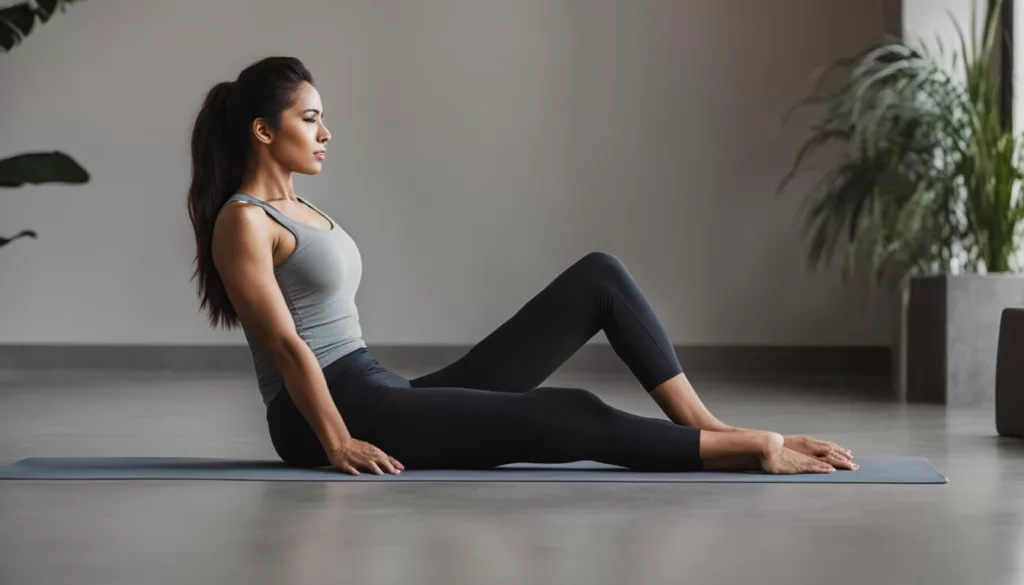The yoga wheel is a versatile prop that has gained popularity among yogis worldwide. Whether you’re a beginner or an advanced practitioner, incorporating the yoga wheel into your practice can enhance your experience and take your yoga to new heights. In this easy guide, we will explore how to use the yoga wheel, various yoga wheel exercises, and the benefits it offers.
Key Takeaways:
- Learn how to use the yoga wheel for strengthening, stretching, and improving your yoga practice.
- Discover the different sizes of yoga wheels and their weight capacities.
- Explore the benefits of using a yoga wheel, including improved posture and relief from back pain.
- Find beginner-friendly yoga wheel exercises to build strength, flexibility, and enhance your overall practice.
- Take your yoga practice to the next level with advanced yoga wheel exercises for backbends and headstands.
What Size Are Yoga Wheels and How Much Weight Can They Hold?
In this section, we will explore the different sizes of yoga wheels and their weight capacity. Understanding the various options available will help you choose the right yoga wheel for your practice.
Sizes of Yoga Wheels
Yoga wheels come in three different sizes: small, medium, and large. Each size offers unique benefits and is suitable for different types of exercises.
- Small Yoga Wheel: This size is perfect for targeted massages and stretching specific areas, such as the neck, shoulders, and feet.
- Medium Yoga Wheel: The medium-sized wheel is versatile and great for toning exercises, improving balance, and enhancing core strength.
- Large Yoga Wheel: The largest wheel provides more stability and balance, making it ideal for deeper stretches and challenging poses.
Weight Capacity
One of the key factors to consider when choosing a yoga wheel is its weight capacity. Yoga wheels are designed to be sturdy and can typically hold up to 500 pounds of weight. This means that yogis of all sizes can safely use the wheel without worrying about it breaking under pressure.
Having a yoga wheel with a high weight capacity not only ensures safety but also allows you to fully explore and engage in various yoga poses without limitations.
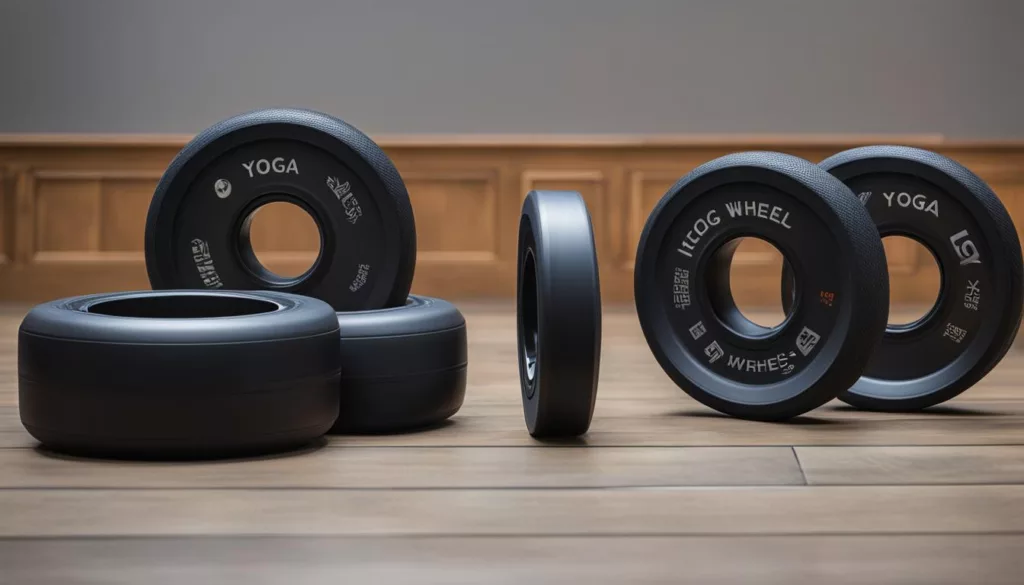
As you can see in the table above, different sizes of yoga wheels have different weight capacities. This information can help you make an informed decision when purchasing a yoga wheel that suits your needs.
Now that you know the sizes and weight capacity of yoga wheels, you can confidently choose the right wheel to enhance your yoga practice.
Section 3: Benefits of Using a Yoga Wheel
The yoga wheel offers a wide range of benefits that can enhance your yoga practice. Whether you’re looking to improve your posture, relieve back pain, increase flexibility, or strengthen your core, the yoga wheel can be a valuable tool to incorporate into your routine.
One of the primary benefits of using a yoga wheel is its ability to improve posture. By gently rolling the wheel along your spine, it helps to release tension and align your vertebrae, promoting proper posture and reducing the risk of posture-related issues.
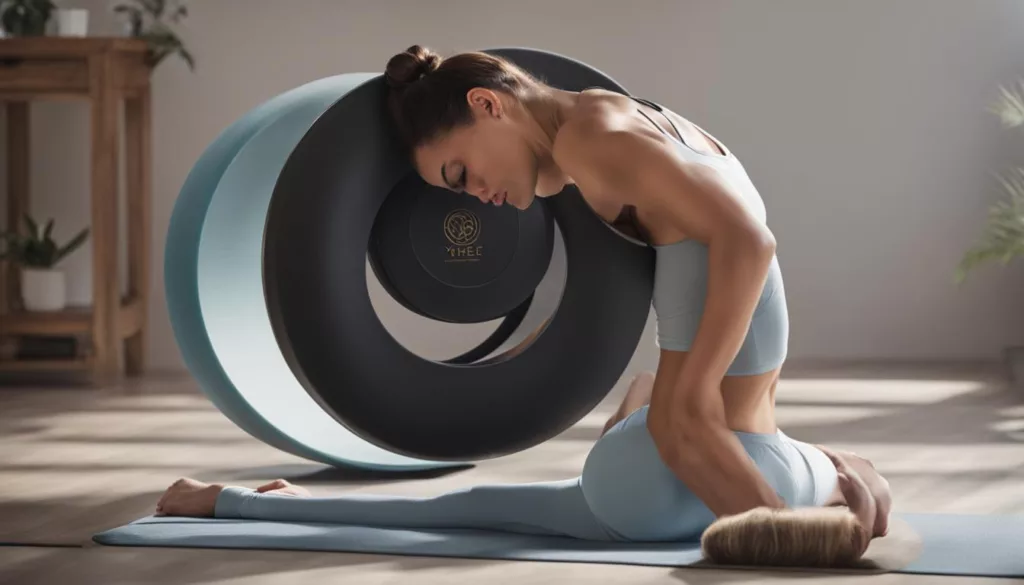
The yoga wheel is also an excellent tool for relieving back pain. The gentle backbends and stretches performed with the wheel can help to lengthen and decompress the spine, providing relief from tight muscles and tension.
In addition to its benefits for back health, the yoga wheel is highly effective in enhancing flexibility. By using the wheel to support and deepen stretches, you can safely and gradually improve your range of motion, allowing you to move more freely and comfortably in your practice.
To further challenge your practice and build core strength, the yoga wheel can be used to perform various exercises that target your abdominal muscles. By incorporating the wheel into movements like planks and bridges, you engage your core in a unique way, improving stability and balance.
Benefits of Using a Yoga Wheel:
- Improves posture
- Relieves back pain
- Enhances flexibility
- Strengthens core muscles
Incorporating the yoga wheel into your yoga practice can unlock a world of benefits, both physically and mentally. It allows you to explore new poses, deepen stretches, and challenge your body in different ways. By embracing the versatility of the yoga wheel, you can take your practice to new heights and discover the transformative effects it can have on your overall well-being.
Yoga Wheel Exercises for Beginners
If you’re a beginner looking to incorporate the yoga wheel into your practice, you’re in the right place. The yoga wheel can be a powerful tool for building strength, improving flexibility, and enhancing your overall yoga experience. Here are some beginner-friendly exercises to get you started:
1. One-Legged Balancing Pose:
This pose helps improve balance and stability while engaging the core and leg muscles. Start by placing the yoga wheel under one foot, keeping the opposite leg lifted and extended. Gently roll the wheel forward and backward as you find your balance. Repeat on the other side.
2. Virabhadrasana II (Warrior II):
Warrior II is a classic yoga pose that strengthens the legs, opens the hips, and improves focus. To incorporate the yoga wheel, stand with your feet wide apart and place the wheel between your front foot and the arch of your back foot. Inhale as you extend your arms out to the sides, parallel to the floor. Keep your gaze focused on your front hand and hold the pose for a few breaths.
3. Halasana (Plow Pose) Stretch:
The yoga wheel can be a great prop to deepen your stretches. To perform Halasana with the wheel, lie on your back and place your feet on the wheel, knees bent. Inhale as you lift your hips and roll the wheel towards your head, extending your legs overhead. Use your hands to support your lower back for stability. This pose stretches the spine, hamstrings, and shoulders.
4. Cat-Cow Pose for Back Pain Relief:
If you experience back pain, the yoga wheel can offer relief. Start on all fours, with the wheel placed under your hands. Inhale and arch your back, lifting your chest and tailbone towards the ceiling (Cow Pose). Exhale and round your spine, tucking your chin and tailbone under (Cat Pose). Move through these poses in a gentle, flowing motion to release tension in the back.
Remember, as a beginner, it’s important to listen to your body and practice with mindfulness. Start slowly and gradually increase the intensity of your yoga wheel exercises. With regular practice, you’ll build strength, improve flexibility, and take your yoga journey to new heights.

Yoga Wheel Exercises for Advanced Practitioners
For advanced practitioners looking to challenge themselves in their yoga practice, the yoga wheel offers a range of exercises that can take your skills to the next level. The wheel can be used to deepen backbends, improve stability in inversions, and enhance overall strength and flexibility.
One advanced yoga wheel exercise is the Advanced Backbend. This pose requires a strong back and open shoulders. Start by sitting on the floor with the wheel behind you. Slowly lean back and place your hands on the wheel, fingers pointing towards your feet. Engage your core and press into the wheel as you lift your chest towards the ceiling. Hold the pose for several breaths and slowly release.
Another challenging exercise is the Headstand Variation. Begin by placing the wheel on the floor and coming into a headstand with your forearms balanced on the wheel. Use your core strength to lift your legs off the ground and extend them upwards. This pose requires balance and stability, so be sure to engage your core and keep your gaze focused to maintain control.
Remember to always listen to your body and only attempt advanced poses if you feel confident and comfortable. It’s important to warm up properly before attempting these exercises and to use proper form and alignment throughout. With practice and dedication, the yoga wheel can become a valuable tool in advancing your yoga practice.
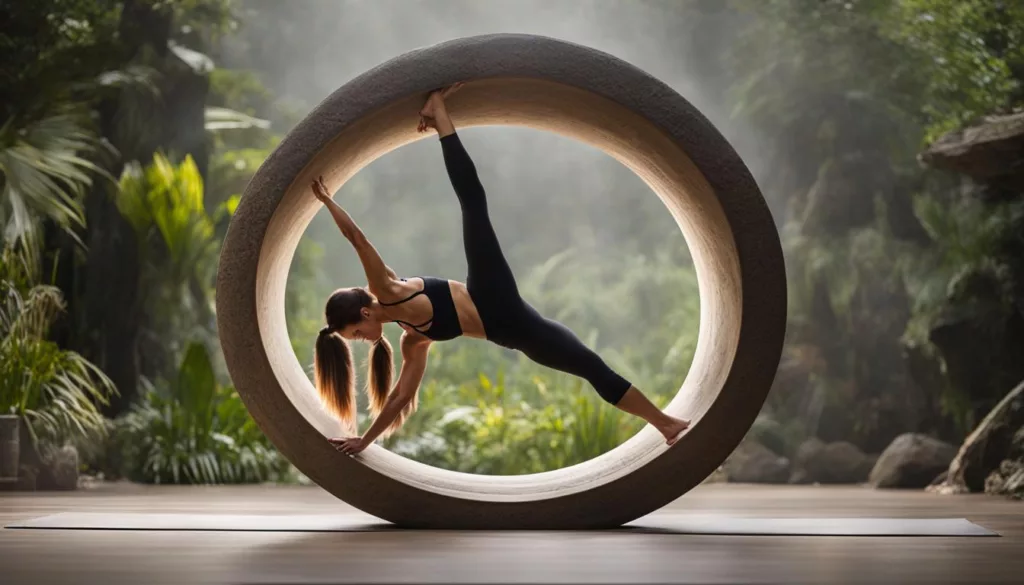
| Yoga Wheel Exercises for Advanced Practitioners | Description |
|---|---|
| Advanced Backbend | A pose that deepens backbends and improves back strength and flexibility. |
| Headstand Variation | An inversion pose that challenges balance and stability while strengthening the core. |
| Disclaimer: These exercises are for advanced practitioners and should only be attempted if you have a strong foundation in yoga and feel confident in your abilities. Always consult with a certified yoga instructor before attempting advanced poses. | |
Section 6: Tips and Tricks for Using the Yoga Wheel
Using the yoga wheel can be a transformative experience in your yoga practice. However, it can also be challenging, especially for beginners. To help you make the most out of your yoga wheel practice, we have compiled a list of tips and tricks that will enhance your experience and ensure safety.
Start with simple exercises
When first using the yoga wheel, it’s important to start with simple exercises that allow you to get comfortable with the prop. Begin by placing the wheel under your feet and rolling back and forth to gently stretch your calves and hamstrings. As you become more familiar, you can incorporate the wheel into classic yoga poses like downward dog or bridge pose, using it to deepen your stretch or provide support.
Listen to your body
As with any yoga practice, it’s crucial to listen to your body and honor its limitations. The yoga wheel can provide a deep stretch, but it’s important not to push yourself too far. If you feel any pain or discomfort, back off and modify the pose or the intensity. Remember, yoga is a personal journey, and each body is unique.
Be patient with yourself
Using the yoga wheel requires balance, strength, and flexibility, which may take time to develop. Be patient with yourself and embrace the learning process. Start with smaller movements and gradually increase the difficulty level as you gain confidence and stability. With consistent practice, you’ll notice improvements in your overall yoga practice.
Use proper form and alignment
Proper form and alignment are key to safely and effectively using the yoga wheel. Pay attention to the placement of your hands, feet, and body, ensuring that your spine is neutral and your core is engaged. Don’t rush through the poses; instead, focus on maintaining stability and control throughout each movement.
Warm up before using the wheel
Before using the yoga wheel, it’s important to warm up your body to prevent injuries. Start with a gentle warm-up routine, incorporating movements that target the areas you’ll be working on with the wheel. This will help prepare your muscles and joints for the added challenge.
Remember, the yoga wheel is a tool to enhance your practice, but it’s not a must-have. If you find that the wheel doesn’t resonate with you, explore other props or modifications that suit your needs and preferences. The key is to find what works best for your body and allows you to deepen your yoga practice.
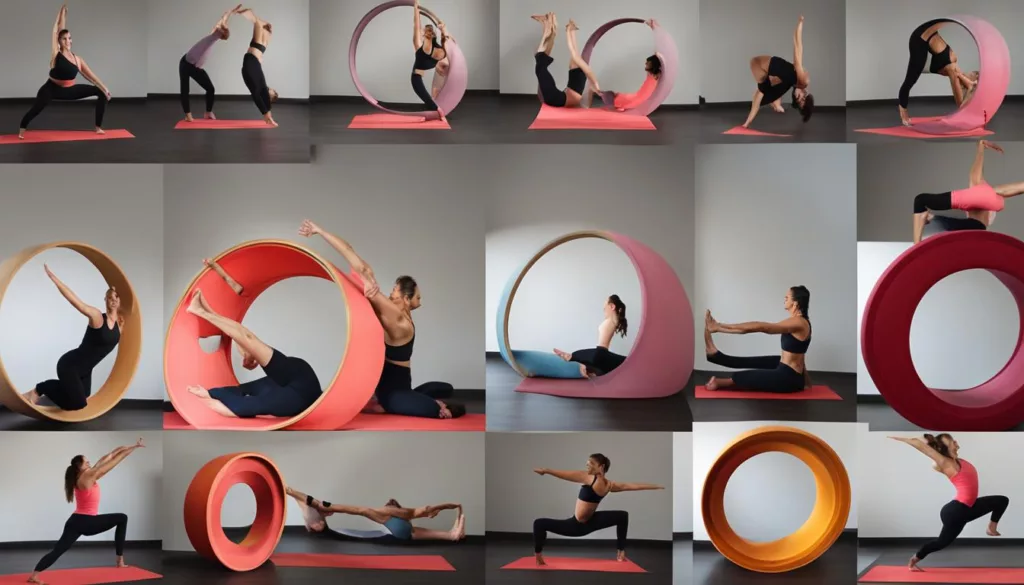
Conclusion
In this yoga wheel guide, we have explored the various aspects of using a yoga wheel to enhance your yoga practice. Whether you are a beginner or an advanced practitioner, the yoga wheel can be a valuable prop to improve strength, flexibility, balance, and posture.
Throughout this guide, we have discussed the different sizes and weight capacities of yoga wheels, as well as the benefits they offer. From relieving back pain and improving posture to deepening stretches and challenging balance, the yoga wheel has something to offer everyone.
For beginners, we have provided a range of easy exercises to get started with, focusing on building strength, improving flexibility, and relieving back pain. Advanced practitioners can explore more challenging poses, using the yoga wheel to deepen backbends and enhance stability in inversions.
As you embark on your yoga wheel journey, it’s important to remember some key tips and tricks. Start with simple exercises, listen to your body, and be patient with yourself. Prioritize proper form and alignment, and always warm up before using the wheel. And most importantly, have fun and let the yoga wheel add a new dimension to your practice!
FAQ
What sizes do yoga wheels come in and how much weight can they hold?
Yoga wheels come in small, medium, and large sizes. They can hold up to 500 pounds of weight, making them suitable for yogis of all sizes.
What are the benefits of using a yoga wheel?
Using a yoga wheel can help improve posture, release tension in the back, relieve back pain, enhance flexibility, and promote core strength.
What are some easy yoga wheel exercises for beginners?
Beginners can try balancing postures like one-legged balancing pose, strength-building poses like Virabhadrasana II, deep stretches like Halasana, and back pain relief with the cat-cow pose.
What are some advanced yoga wheel exercises for advanced practitioners?
Advanced practitioners can explore using the yoga wheel to assist in advanced backbends like Wheel Pose and improve stability and balance in headstands.
What are some tips and tricks for using the yoga wheel?
Start with simple exercises, listen to your body, be patient with yourself, use proper form and alignment, warm up before using the wheel, and explore different poses and variations that suit your needs and preferences.
How can the yoga wheel enhance my yoga practice?
The yoga wheel is a versatile prop that can help improve strength, flexibility, balance, and overall posture, taking your yoga practice to new heights.

